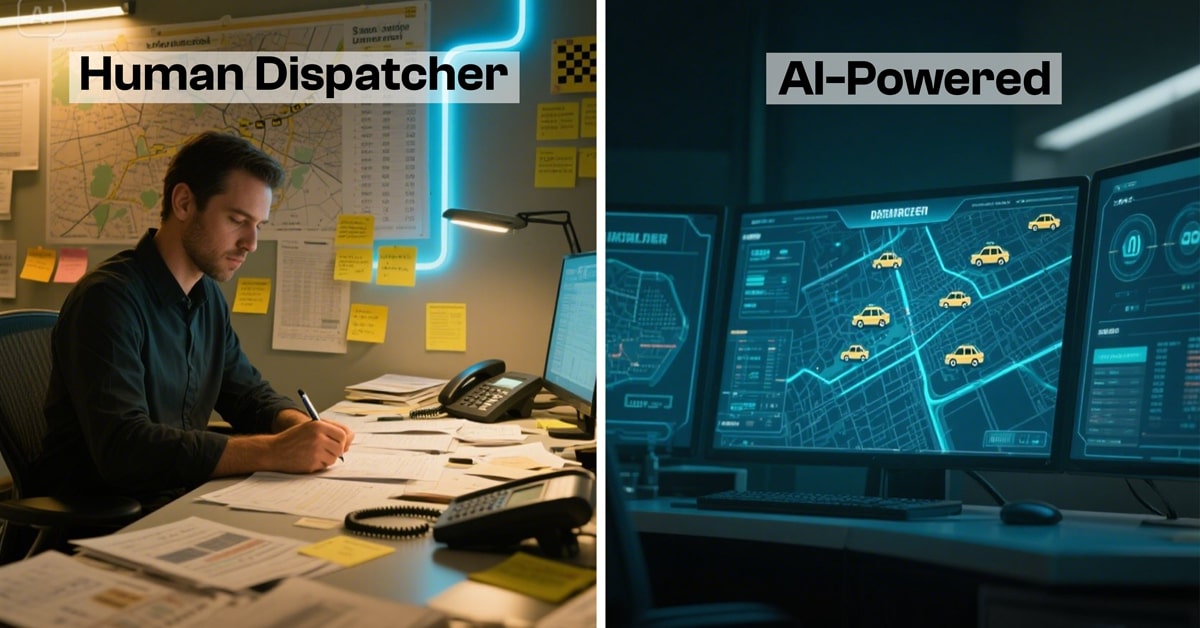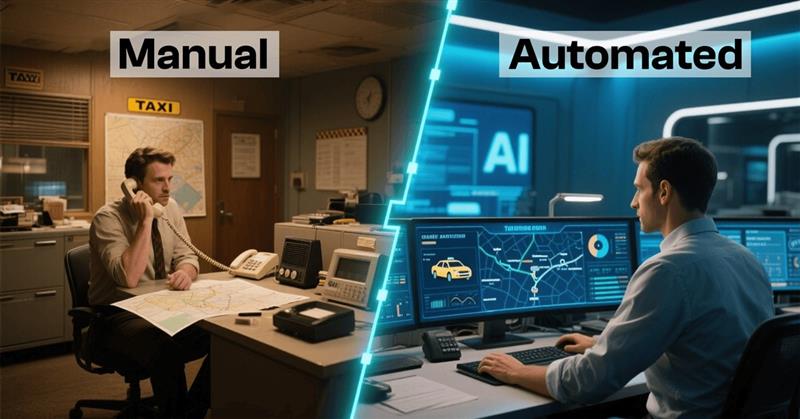Transition from manual taxi dispatching with high dependence on human labour to sophisticated software-driven automation, we’ve come a long way. This transition has not only made taxi dispatching systems highly efficient but has also made these services more user-centric and safe, providing a top-notch experience like never before.
In this blog, we’ll take a look at the evolution of the taxi dispatching industry and how technology is playing an irreplaceable role in the modernization of the taxi-hailing industry.
The Early Era of Taxi Hailing
Historically, taxi hailing was quite a manual task. In the early days, taxi hailing started with simple road hailing. Potential waved down a cab, asked whether the taxi could take them to their destination, and was done, no matter if the taxi business was small or large.
Related Article: How AI Can Change the Taxi Industry
Related Article: How Cabsoluit Transforms Taxi Dispatch Operations.
Manual systems involved
● Radio Communication
This involved the dispatcher guiding the taxi drivers about which route and customer they had to provide a ride to. This involved a lot of communication between the dispatcher and the taxi driver through the radio. This method sounds effective, but it was quite time-consuming as well as error prone.
● Paper Records and Logs of All Rides
Every trip of every driver associated with a company was recorded on paper. It was labour intensive task which not only made it expensive but also it was very difficult to have follow-ups or even spot mistakes.
This method also involved the assignment of drivers based on the information of the location of drivers and availability of drivers as known by the dispatcher, but this was not quite an efficient approach, as it led to many inefficiencies.
Related Article: How to Choose the Best Taxi Dispatch Software in 2025
Digitalization In Taxi Dispatching System
In the late 1980s and early 1990s a wave of change was seen in taxi dispatch systems and organization. The computerized dispatching systems made the process less labour and paper-intensive, increasing efficiency in this industry.
● Automated Dispatching
The very first automated or computerized dispatching involved feeding the booking information into the system.
The software-based systems were able to match the details with the nearest available driver automatically. This helped with dispatch automation, increasing booking efficiency.
● Electronic Reporting
Automated or software-based dispatch systems eliminated the need for manual reporting based on paper, reducing paper-based practices. All recorders of taxi hailing and booking became electronic.
It means that all records of to-and-from destinations became electronic. This made reporting less error prone and easier to spot mistakes or track records.
● Clear and Easy Communication
With digitalization, communication between dispatchers and taxi drivers has become simpler and clearer. Drivers were provided digital routes they needed to follow, and the instructions were also digitalized.
This removed the need for countless radio communications. This not only made communication and digestion of instructions easier but also made it possible to reduce delays as much as possible.
This era of computerization paved the way for modernization in the taxi dispatching industry. This paved the way for dispatch automation, dynamic routing, and improved dispatch management and delivery that we see today, all thanks to technological advancements.
Related Article: Top 10 Best Taxi Dispatch Softwares In 2025
The GPS and Real-Time Tracking Era
The introduction of GPS proved an important innovation for the taxi business. The introduction of GPS in the early 2000s improved the experience of taxi booking services for the better.
For fleet managers, GPS made live tracking possible, enabling them to experience a system of dispatching they had never seen before.
The following are some of the benefits and improvements GPS has introduced in taxi-hailing businesses:
Accurate Information About Location
The groundbreaking invention of GPS helped track the information of drivers’ location quite accurately. This allowed dispatchers to easily assign drivers to the nearest customers and vice versa.
The GPS removed the need for human judgement or assessment of how far the driver may be, making it quite easy to match drivers to customers.
Improved Customer Experience
GPS also allowed the customers to have an idea of how far the driver is and how much time it would take for the cab to arrive, making the cab-hailing process much easier.
The customers had real-time estimations of the arrival time of the driver, which helped to cut the waiting time and confusion about the location.
The GPS removed the need for human judgement or assessment of how far the driver may be, making it quite easy to match drivers to customers.
Dynamic Router Management
GPS systems help with dynamic routing. Drivers could easily change the routes if they were trafficked, the road is closed due to any situation, they could easily change the routes instead of wasting time in traffic.
This helped drivers to get to destinations in the shortest time possible and helped to avoid many inconveniences on the way.
The GPS-based dispatch software was a big step in the evolution of taxi dispatching and was a steppingstone for the automated systems we see today.
Related Article: Importance of Transport System in Modern Transportation Sector.
Mobile Apps and on-Demand Dispatching
The emergence of cell phones further revolutionized taxi dispatching software. This invention changed so that people could rent taxis. The cabs became just a few clicks away from users. Some benefits include:
Booking Ride in Few Clicks
With the use of cell phones, passengers were empowered and were able to book rides with just a few clicks. They could even get an estimate of how long it would take the driver to arrive, the real-time location of the driver, and even get an estimate of the fare they would have to pay. They can use booking terminals like in case of Cabsoluit.
Efficient Notifications
Through mobile apps and notifications, it became very easy for drivers to accept the rides, and even notifications like the driver has arrived, made ride-hailing very efficient, and reduced idle time as users were well-informed through notifications.
Cashless Payments
Online payments through in-app payments made riding services much more compatible, safe, and convenient.
At this stage, the taxi dispatching system was completely unrecognizable compared to the early ages, providing a lot of control to the users and drivers through seamless bookings and payment methods.
From Human-Scheduled to AI-Powered Dispatch Systems

Today, taxi dispatch systems rely on artificial intelligence and machine learning models to optimize efficiency, standards for users, and the decision-making process.
AI-based Ride Booking
Now ML algorithms are used to efficiently match the riders with the driver. All the conditions like drivers’ current location, the distance a driver will have to cover to reach the pick-up location, traffic conditions, taxi models preferred by user, fare users are willing to pay, and driver’s availability all are considered by these algorithms.
Based on all these conditions, the machine learning algorithms match the riders effectively with a potential driver. You can book
Predictive Analysis
Based on past data, the machine algorithms even predict the rush hours for different routes, enabling the taxi businesses to make decisions on which routes they should use and how they should dispatch their fleet.
Improved Customer Support
Modern and AI-based dispatch systems even use chatbots and AI-based customer support to answer FAQs and provide customer support instead of human support teams.
With AI-based dispatch systems, taxi businesses are able to improve the speed and efficiency of their services, providing a better user experience.
Future of Taxi Dispatching
The future of taxi dispatching systems involves IoT and integration of autonomous vehicles. Real-time traffic information, passenger feedback and health of vehicles would be transferred directly to dispatching systems. The adoption of IoT-enabled automobiles can optimize taxi businesses.
Autonomous Dispatching
Fully autonomous vehicles would provide control of orders for driverless taxis, creating complete independence in dispatching systems. This could lead to significant efficiencies and safety levels.
Future Higher Degrees of Customer Personalization
AI dispatching systems can easily personalize commuters’ ride options and provide a better ride experience based on their preferences and ride histories.
Conclusion
The introduction of technology has made taxi dispatching systems unrecognizable, optimal, and efficient. The technologies like GPS, mobile applications and AI have made the development faster and efficient that has helped taxi businesses to provide efficient, smooth and user-friendly experience.
The taxi businesses that keep up with technological advancements can provide a top-notch experience to the users and provide a competitive edge in the dynamic and highly competitive market.




